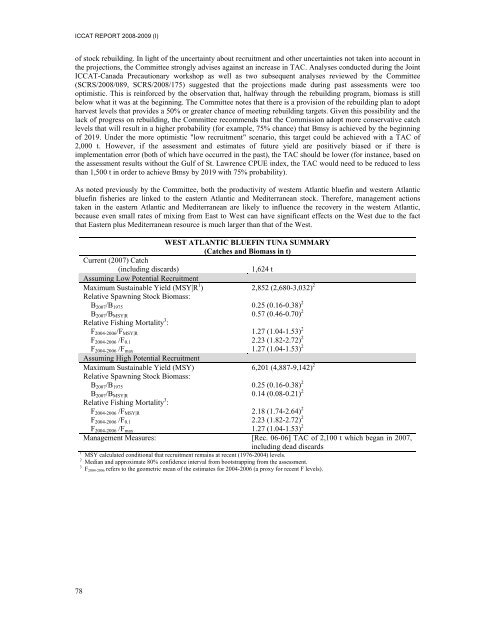REPORT OF THE STANDING COMMITTEE ON RESEARCH ... - Iccat
REPORT OF THE STANDING COMMITTEE ON RESEARCH ... - Iccat
REPORT OF THE STANDING COMMITTEE ON RESEARCH ... - Iccat
You also want an ePaper? Increase the reach of your titles
YUMPU automatically turns print PDFs into web optimized ePapers that Google loves.
ICCAT <strong>REPORT</strong> 2008-2009 (I)of stock rebuilding. In light of the uncertainty about recruitment and other uncertainties not taken into account inthe projections, the Committee strongly advises against an increase in TAC. Analyses conducted during the JointICCAT-Canada Precautionary workshop as well as two subsequent analyses reviewed by the Committee(SCRS/2008/089, SCRS/2008/175) suggested that the projections made during past assessments were toooptimistic. This is reinforced by the observation that, halfway through the rebuilding program, biomass is stillbelow what it was at the beginning. The Committee notes that there is a provision of the rebuilding plan to adoptharvest levels that provides a 50% or greater chance of meeting rebuilding targets. Given this possibility and thelack of progress on rebuilding, the Committee recommends that the Commission adopt more conservative catchlevels that will result in a higher probability (for example, 75% chance) that Bmsy is achieved by the beginningof 2019. Under the more optimistic "low recruitment" scenario, this target could be achieved with a TAC of2,000 t. However, if the assessment and estimates of future yield are positively biased or if there isimplementation error (both of which have occurred in the past), the TAC should be lower (for instance, based onthe assessment results without the Gulf of St. Lawrence CPUE index, the TAC would need to be reduced to lessthan 1,500 t in order to achieve Bmsy by 2019 with 75% probability).As noted previously by the Committee, both the productivity of western Atlantic bluefin and western Atlanticbluefin fisheries are linked to the eastern Atlantic and Mediterranean stock. Therefore, management actionstaken in the eastern Atlantic and Mediterranean are likely to influence the recovery in the western Atlantic,because even small rates of mixing from East to West can have significant effects on the West due to the factthat Eastern plus Mediterranean resource is much larger than that of the West.WEST ATLANTIC BLUEFIN TUNA SUMMARY(Catches and Biomass in t)Current (2007) Catch(including discards)1,624 tAssuming Low Potential RecruitmentMaximum Sustainable Yield (MSY|R 1 ) 2,852 (2,680-3,032) 2Relative Spawning Stock Biomass:B 2007 /B 1975 0.25 (0.16-0.38) 2B 2007 /B MSY|R 0.57 (0.46-0.70) 2Relative Fishing Mortality 3 :F 2004-2006 /F MSY|R 1.27 (1.04-1.53) 2F 2004-2006 /F 0.1 2.23 (1.82-2.72) 2F 2004-2006 /F max 1.27 (1.04-1.53) 2Assuming High Potential RecruitmentMaximum Sustainable Yield (MSY) 6,201 (4,887-9,142) 2Relative Spawning Stock Biomass:B 2007 /B 1975 0.25 (0.16-0.38) 2B 2007 /B MSY|R 0.14 (0.08-0.21) 2Relative Fishing Mortality 3 :F 2004-2006 /F MSY|R 2.18 (1.74-2.64) 2F 2004-2006 /F 0.1 2.23 (1.82-2.72) 2F 2004-2006 /F max 1.27 (1.04-1.53) 2Management Measures: [Rec. 06-06] TAC of 2,100 t which began in 2007,including dead discards1 MSY calculated conditional that recruitment remains at recent (1976-2004) levels.2 Median and approximate 80% confidence interval from bootstrapping from the assessment.3 F 2004-2006 refers to the geometric mean of the estimates for 2004-2006 (a proxy for recent F levels).78
















